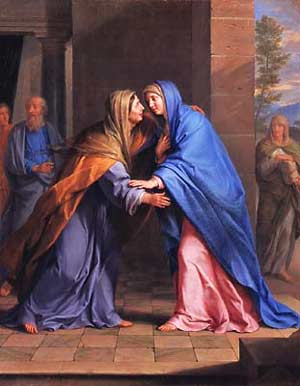Scripture: Lectionary 572. Feast of the Visitation of Mary to Elizabeth. Zephaniah 3:14-18. Romans 12:9-16. Isaiah 12:2-3.4.5-6. Luke 1:39-56:
What a beautiful feast ends the month dedicated to Mary our Mother. I was lead to think about this feast by recalling some of the most beautiful paintings depicting the meeting of the two blessed and prophetic women, Mary and her cousin Elizabeth. Both have been overshadowed and filled with the Holy Spirit with the result that nothing is impossible for them through God. A young virgin is pregnant and an elderly woman is pregnant. This is unique not only in the world but in all of the writings about women; it is a unique event in the New Testament and it is worthy of our prolonged meditation upon it.
In the Society of Mary we have dedicated three years to reflect, renew, and respond to the calls of God in our lives. These words are on a lamenated prayer that was sent to each member of our Province and it contains painting with Mary and Elizabeth holding a circle around their womb that contains the image of John the Baptist with Mary’s image containing that of her son Jesus in a seated position. The artist has joined a long line of other artists who capture the meaning of the Feast in an ascetical and deeply spiritual way—the way of beauty, goodness, and truth. Mary’s right hand is hidden with Elizabeth’s also being hidden. They are united in the mystery taking place beat by beat within them. I recall the second joyful mystery of the Rosary which has as its fruit of prayer love for our neighbor.
These two blessed women meet and embrace while they are equally experiencing new life within their bodies. It is a life that will be fruitful for the salvation of all humankind. One will announce, herald, and witness to this in the person of John; the other will preach, teach, heal and give his life for the salvation of everyone as he dies on the Cross. All of these miracles are taking place in sacred blessedness, womanly warmth of love, and total self-giving. Mary brings the Lord of life to Elizabeth who as a prophetess declares that Mary is blessed and blessed is the fruit of her womb. The Visitation is a mystery o f joy, love, salvation, and hospitality. Gifts of the Holy Spirit are in superabundance.
There are two readings possible for the first reading in the liturgy. The first comes from the prophet Zephaniah and contains the symbol of the Daughter of Zion. It is appropriated by spiritual writers to reflect Mary who stems from
Galilee in the land of Israel. There are four other prophetic texts that have the same content about the Daughter of Zion who contains the “king” within her walls. This image is transferred to Mary who contains Jesus within the walls of her womb. Our reponsorial comes from Isaiah who also has this same image. Both Catholic and Protestant writers have commented on the title of Daughter of Zion as applied to Mary, the mother of Jesus.
I did not want to forget a second choice for this feast’s first reading, that taken from Romans 12:9-16. In reflecting upon this text Paul is exhorting us to have the virtues, dispositions, and attitudes of a follower of Christ. Even more so would the two blessed women, Mary and Elizabeth model these traits of the spiritual life for believers both Jewish and Christian. Both are graced by the Holy Spirit not only with these virtues but with the very life of God in Jesus, and holiness in John the Baptist.
A feast in honor of these two holy women calls for a song. What better song than the one that Mary sings in her Magnificat. We join in the first part of the song in praising God by realizing our total dependence on the Creator and total openness to the plan of salvation we see in the pregnancy of these two holy and saintly women. Love and humility abound within the verses; they then break into the strong prophecy that Mary proclaims about God raising the lowly and lifting up the poor and gracing the believers who see the promises made to Abraham being accomplished. God’s love overcomes all that is oppressive or evil in this world. The women testify to the goodness and loveliness of God which is mirrored in their own beauty and blessedness.
A Prayer of Reflection, Renewal, and Response for the Visitation:
God, in O love you created, redeemed and sanctified your people! Bless our journey through these three years of spiritual renewal that we may come to celebrate more deeply our Marianist heritage.
At the Visitation Mary and Elizabeth (the young and the old) met in a joyful embrace, filled with expectant life. Blessed by the Holy Spirit, they sang to each other, “My soul rejoices in God my savior’ and “Blessed are you among women.”
May we as brothers of the Marianist Province of the United States, alive with the charism of Blessed Chaminade, rejoice in his legacy and realize that we, too, young and old, are blessed and filled with your life so we may witness and proclaim your living presence for the salvation of the world. Amen.
Copyright 2013 Fr. Bertrand Buby, S.M.
About the Author

Guest
We welcome guest contributors who graciously volunteer their writing for our readers. Please support our guest writers by visiting their sites, purchasing their work, and leaving comments to thank them for sharing their gifts here on CatholicMom.com. To inquire about serving as a guest contributor, contact editor@CatholicMom.com.



.png?width=1806&height=731&name=CatholicMom_hcfm_logo1_pos_871c_2728c%20(002).png)
Comments